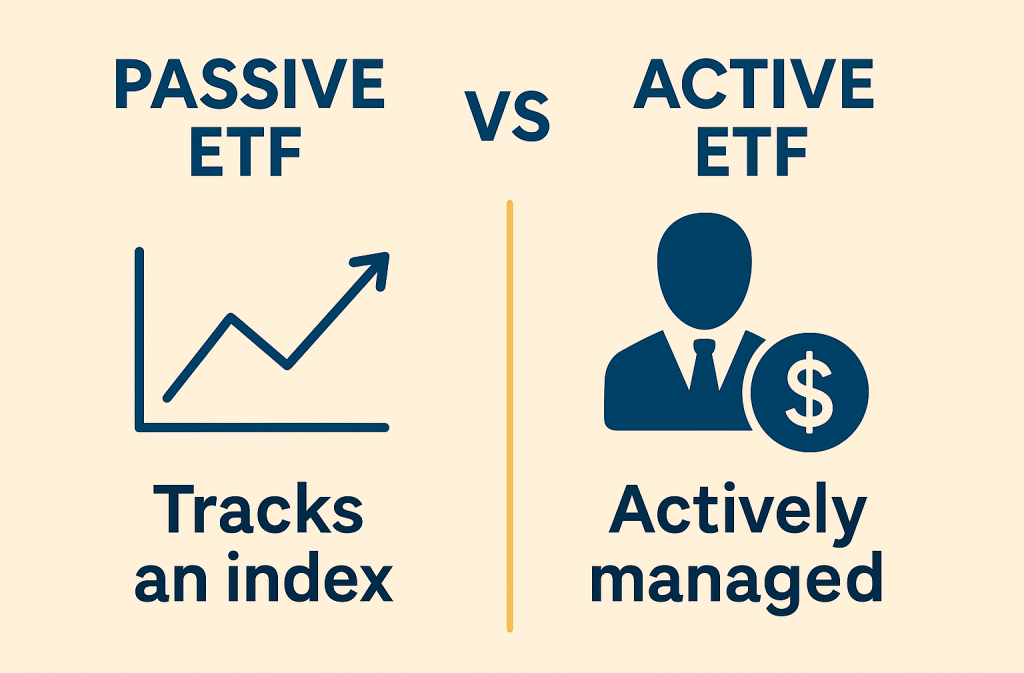If you’re new to ETF investing, you’ve probably heard the terms “passive” and “active” ETFs.
But what do they really mean, and which one is right for you?
Let’s break it down in a beginner-friendly way.
✅ What Is a Passive ETF?
A passive ETF simply follows a specific index, such as the S&P 500, Nasdaq 100, or Russell 2000.
🟢 Key Features:
- No active decision-making → portfolio mirrors the index
- Lower fees → usually 0.03% to 0.30% per year
- Predictable returns → goal is to match the market
- Broad diversification → hundreds of companies in one fund
💡 Examples:
- Vanguard S&P 500 ETF (VOO)
- Invesco QQQ Trust (QQQ)
- iShares Russell 2000 ETF (IWM)
👌 Best for:
- Beginners just starting with ETFs
- Long-term investors who want stability
- Anyone seeking market-average returns
✅ What Is an Active ETF?
An active ETF is managed by professionals who select and adjust holdings in an attempt to beat the market.
🟠 Key Features:
- Active strategy → managers buy/sell based on research & outlook
- Higher fees → often 0.30% to 1.00% per year
- Potential for outperformance → but not guaranteed
- More frequent portfolio changes
💡 Examples:
- JPMorgan Equity Premium Income ETF (JEPI)
- ARK Innovation ETF (ARKK)
- T. Rowe Price Dividend Growth ETF (TDVG)
👌 Best for:
- Investors aiming for higher-than-market returns
- Those comfortable with higher risk and volatility
- People who like thematic or story-driven investing
🧭 Side-by-Side Comparison
| Category | Passive ETF | Active ETF |
|---|---|---|
| Management | Tracks an index | Managed by professionals |
| Fees | Low (0.03% – 0.30%) | Higher (0.30% – 1.00%) |
| Risk | Market-level risk | Higher, depends on manager’s skill |
| Expected Return | Market average | Aim to outperform market |
| Predictability | High | Low |
| Examples | VOO, QQQ, IWM | JEPI, ARKK, TDVG |

❗ Which Should You Choose?
- If you’re a beginner or want long-term, stable growth → Start with passive ETFs.
- If you’re more experienced and willing to take risks for higher returns → Explore active ETFs.
💡 Remember: Higher fees and risks don’t always guarantee higher performance.
📝 Final Takeaway
ETFs are powerful tools for building wealth, but the choice between active and passive depends on your investing style.
🎯 Ask yourself:
- Do I want steady, predictable growth? → Go passive.
- Am I willing to take extra risk for a chance to beat the market? → Consider active.
👉 The smartest move? Start with a passive core portfolio, then add selective active ETFs if you want more opportunity.
📝 Disclaimer
This article is intended for educational purposes only. It does not constitute financial, investment, or legal advice. All investment decisions involve risks, and readers should conduct their own research or consult with a licensed financial advisor.
